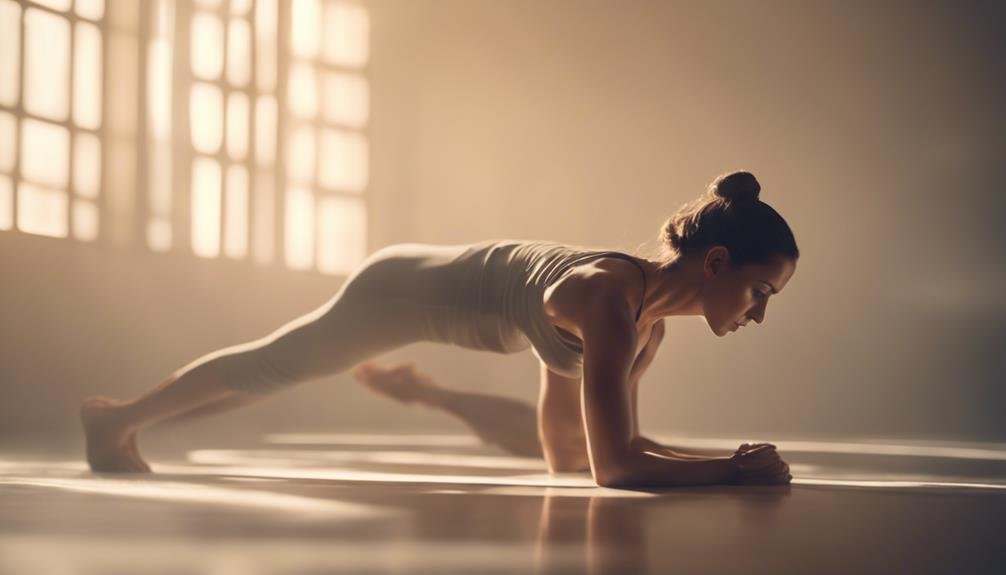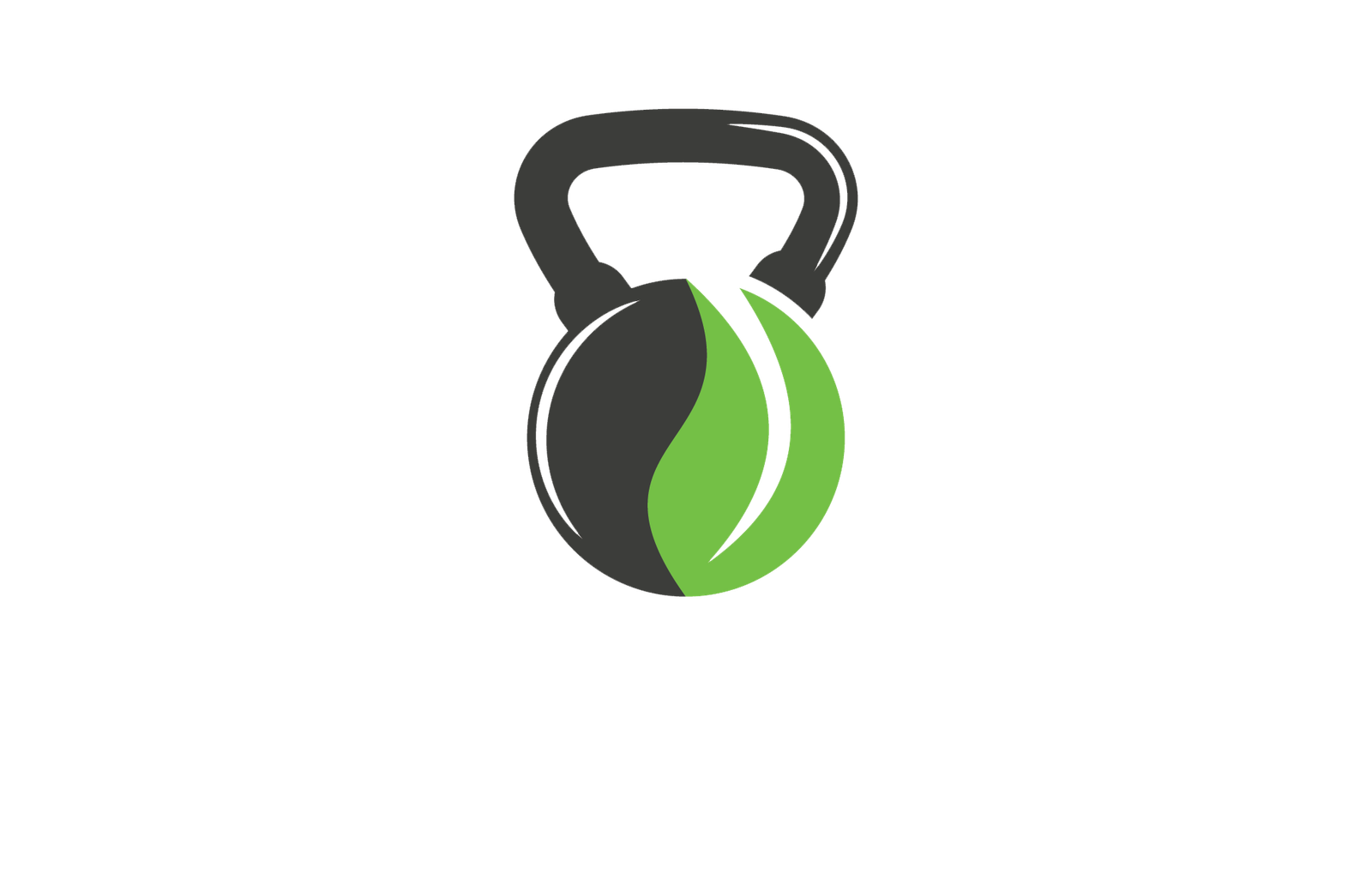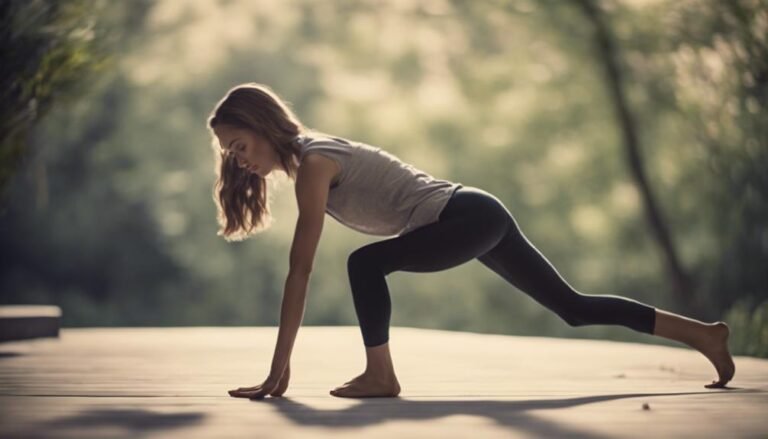Don't miss our holiday offer - 20% OFF!

Yoga Poses to Strengthen Your Core
Discover dynamic yoga poses that ignite your inner power and stability, transforming your core strength and connection to your body.
We build a strong core through a combination of foundational poses, balancing acts, inversions, twists, and advanced postures that work together to ignite our inner power and stability. We start with foundational poses like Eagle and Tree, which cultivate awareness and generate power from our core. Balancing acts challenge our equilibrium, igniting our core's stabilizing force. Inversions, twists, and advanced poses take our practice to the next level, targeting specific core muscles. As we explore these poses, we'll discover a stronger, more resilient core, and tap into a deeper connection to our body and inner strength.
Key Takeaways
- Foundational poses like pelvic alignment and conscious breathing techniques amplify core strength and stability.
- Balancing acts like Eagle Posture and Tree Stances challenge equilibrium and engage the core's stabilizing force.
- Inversions like Headstands and Handstands target the transverse abdominis, obliques, and entire core.
- Twists and turns like Marichyasana III and Ardha Matsyendrasana ignite core power and improve flexibility and coordination.
- Advanced poses like Eka Pada Rajakapotasana and Asthavakrasana demand intense core engagement for balance, stability, and control.
Foundational Poses for Core Strength
As we venture into the world of core-strengthening yoga poses, we begin with the foundational ones that set the stage for a stronger, more stable core. These foundational poses are the building blocks of a robust core, and mastering them is crucial before moving on to more advanced practices. We focus on cultivating awareness of our pelvic alignment, ensuring it's neutral and engaged. This allows us to generate power and stability from our core, rather than relying on our arms and legs.
As we move through these foundational poses, we integrate conscious breathing techniques to amplify their effectiveness. By synchronizing our breath with each movement, we can tap into our core's full potential. We inhale, lengthening and expanding our core, and exhale, engaging and contracting it. This harmonious union of breath and movement helps us develop a stronger, more resilient core. By practicing these foundational poses with intention and awareness, we create a solid foundation for more advanced core-strengthening practices, setting ourselves up for success in our yoga journey.
Balancing Acts for Core Engagement
What's the secret to tapping our core's full potential: balancing acts that challenge our equilibrium and ignite our core's stabilizing force. By incorporating balancing poses into our yoga practice, we can awaken our core's deep muscles, which are essential for stability and balance. In Eagle Posture, for instance, we engage our core to maintain balance and poise, as we wrap our legs around each other and extend our arms out to the sides. This pose requires focus, control, and a strong connection to our center, which in turn strengthens our core.
Tree Stances are another great way to challenge our balance and engage our core. When we stand on one leg, we need to engage our core to maintain stability and prevent ourselves from toppling over. This subtle engagement of our core muscles helps build strength, stability, and awareness. By incorporating these balancing acts into our practice, we can develop greater core strength, improve our balance, and enhance our overall physical awareness. As we balance, we'll find our core awakening, and our entire practice will become more grounded and empowered.
Core Strengthening Through Inversions
We take our core strengthening to the next level by incorporating inversions into our practice, which challenge our bodies to work against gravity and engage our core muscles in a unique way. Inversions require us to engage our core stabilizers to maintain control and balance, making them an effective way to strengthen our core. However, it's common for many of us to experience inversion anxiety, which is a significant obstacle.
| Inversion | Benefits | Tips |
|---|---|---|
| Headstand | Strengthens entire core, including shoulders and back | Start with wall support and engage your core |
| Handstand | Targets transverse abdominis and obliques | Practice wall handstands to build confidence |
| Forearm Stand | Engages core and improves balance | Focus on slow, controlled movements |
Twists and Turns for Core Power
Now that we've explored the power of inversions, let's rotate our focus to twists and turns that'll ignite our core power and take our practice to the next level. Twists and turns are a game-changer for building core strength, as they require engagement from our entire torso. When we twist, we're not just moving our spine, we're also engaging our obliques, which are the primary muscles responsible for spinal rotation and torso torsion. This means that as we practice twists, we're strengthening our core from multiple angles, creating a more balanced and resilient center.
One of the most effective ways to experience the power of twists is through seated twists like Marichyasana III or Ardha Matsyendrasana. These poses require us to engage our core, while also lengthening our spine and opening our chest. As we inhale, we lengthen our spine, and as we exhale, we twist, allowing our torso to rotate freely. With each repetition, we're building strength, flexibility, and coordination, taking our practice to new heights. By incorporating twists and turns into our practice, we're not only strengthening our core, but also cultivating greater body awareness, balance, and overall well-being.
Advanced Poses for Core Mastery
Taking our core strength to the next level, let's explore advanced poses that will challenge our skills and push our practice to new heights. As we progress in our yoga journey, incorporating poses that target our core from different angles is crucial, engaging our Dynamic Extensions and Core Isolation.
To take our core strength to the next level, we must venture into advanced poses that challenge our skills and push our practice to new heights. As we progress in our yoga journey, mastering poses that target our core from different angles is vital, engaging our Dynamic Extensions and Core Isolation.
- Eka Pada Rajakapotasana: This one-legged king pigeon pose requires engagement of the core muscles to maintain balance and stability.
- Asthavakrasana: This eight-angled pose demands intense core engagement to maintain the twisted, inverted position.
- Pincha Mayurasana: In this feathered peacock pose, we need to engage our core to maintain balance and control.
- Tittibhasana: This firefly pose requires us to isolate our core muscles to maintain the lifted, balanced position.
These advanced poses will challenge our core strength, flexibility, and balance. By incorporating them into our practice, we'll experience a deeper connection with our core, leading to improved overall strength, flexibility, and body awareness.
Frequently Asked Questions
Can I Practice Yoga on a Full Stomach or After Eating?
We don't recommend practicing yoga on a full stomach, as it can lead to digestion issues and discomfort. We suggest waiting at least 2-3 hours after a meal to allow for proper digestion and a comfortable practice.
Do I Need to Be Flexible to Start Practicing Yoga for Core Strength?
"We don't need to be flexible to start practicing yoga; it's about body awareness, not genetic limitations. We can modify poses to suit our needs, and yoga's about progress, not perfection, so let's get started!"
How Often Should I Practice Yoga to See Improvements in Core Strength?
"We aim to practice yoga 2-3 times a week, ideally, but we're realistic about scheduling challenges. Consistency matters, so even 10-15 minutes a day can be beneficial, and we'll take that over sporadic long sessions any day!"
Are Yoga Blocks and Straps Necessary for Beginners?
We get it, investing in proprietary equipment can be intimidating, but trust us, yoga blocks and straps are total game-changers for beginners. These yoga accessories help modify poses, build confidence, and prevent injuries – totally worth the investment!
Can Yoga Alone Replace Traditional Core Exercises Like Planks and Crunches?
We believe yoga can be a great core workout, but it shouldn't replace traditional exercises entirely. Yoga alone might not target all core muscles equally, leading to muscle imbalance; we need a mix for peak core efficiency.
Conclusion
As we conclude our journey through these empowering yoga poses, imagine our cores ablaze with inner fire, radiating strength and stability. We envision our bodies as robust, resilient, and agile, like a mighty tree rooted deep in the earth. With each pose, we've woven a tapestry of core strength, flexibility, and balance, illuminating our path to wholeness and harmony. As we rise from our mats, we embody the essence of yoga: a union of body, mind, and spirit, forever transformed.



